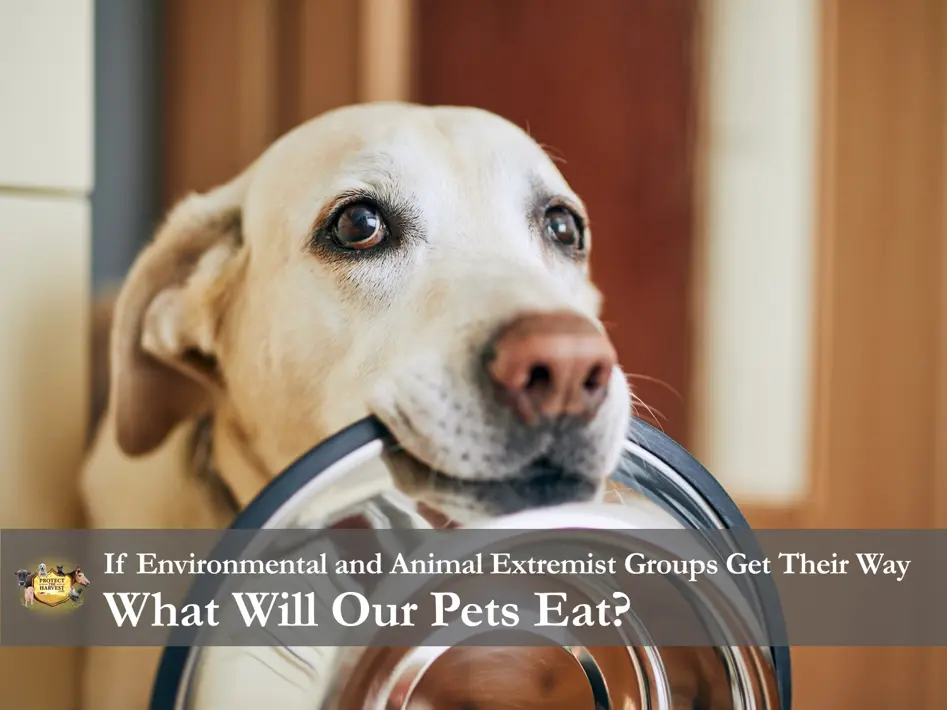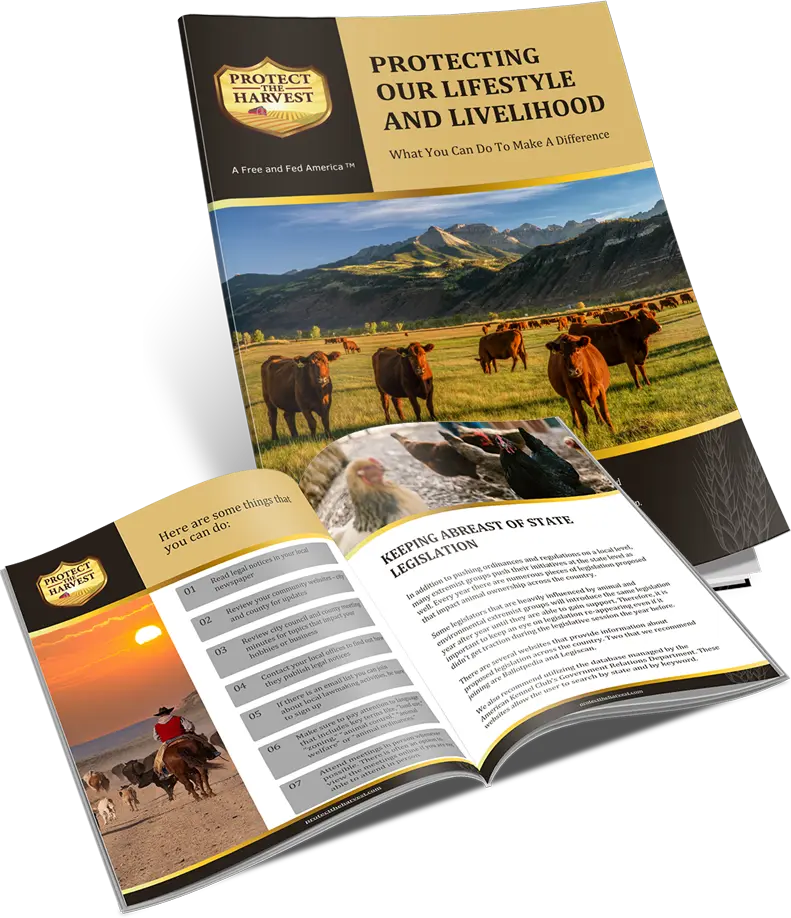
As pet owners, our dogs and cats are important to us in so many ways. One of the most basic and important parts of caring for pets is feeding them. Therefore, it is important to consider where pet food comes from and what will happen if there is no food available to feed them. That could be a real crisis if animal and environmental extremists manage to get their way and shut down animal agriculture were to cease.
According to the American Pet Products Association, pet ownership increased to about 70%, up from 67%, in 2021. The Wall Street Journal reported that pet food sales grew almost 7% in the year ending November 27, 2021, compared to 2.3% for food overall. Pets and their food are big business. So how do we meet the needs of our pets?
This is where animal proteins and products that aren’t utilized by humans come in.
Pet foods use rendered animal ingredients and by-products for pet food. These ingredients are not only healthy, but improve the sustainability of the pet food industry, animal agriculture, and add in valuable nutrients.
At the American Feed Industry Association’s (AFIA) Pet Food Conference in January of 2021, the head of food safety, quality, and regulatory for Pilgrims/JBS USA, Ansen Pond, Ph.D., provided a detailed account of the sustainable benefits of rendering to the pet food industry. These benefits included significant contributions:
• To reduce animal protein, fat, and byproduct waste
• Repurpose water
• Reduce greenhouse gas emissions (GHG)
• Provide fresh meat slurry ingredients to pet food processors.
Animal agriculture has a saying that they “use everything but the moo” (or oink or cluck). In the U.S. meals containing different meat, and cuts comprise of only a portion of a livestock animal.
The raw materials from the animals processed are recaptured and repurposed in many industries including pet food where essential amino acids and fatty acids are valuable for pet nutrition.
Roughly 49% of raw materials from cattle, 37% from poultry, and 44% from swine are considered inedible in the U.S. market for human food. Rather than going to waste, those products are used for numerous products ranging from pet food to asphalt, suture material, gelatin capsules, paint, make-up, pharmaceutical products, and many, many more.
Water used for irrigation is a valuable byproduct of animal agriculture and animal processing. When livestock are rendered, water is removed from animal byproduct ingredients. The water is collected as condensate and then renderers treat and repurpose that water for use in irrigation. This equates to 3.7 billion gallons (29.6 billion pounds) of water released back into the environment every year. To put it into perspective, that equates to about 1,100 Mississippi Rivers.
Almost daily animal and environmental groups are pushing for fake vegan products which are simply not sustainable nor healthy. The reality is this, if pet food producers were to replace animal protein and fat ingredients which are by-products of human food production with vegan alternatives, they’d have to plant and harvest an additional 11 million acres of soybeans and 2.6 million acres of corn. That doesn’t even take into account the additional water needed to grow those crops.
On April 13th, 2022, The Guardian published an article claiming that a “peer-reviewed study” from the University of Winchester, proves that vegan diets are healthier for dogs than commercial diets. The facts are that no veterinary nutritionists advocate for vegan dog food UNLESS they are formulated by a licensed veterinary nutritionist and there are no other alternatives. Cats simply cannot subsist on a vegan diet even though there are those vegans who believe they can. A vegan diet for cats is inhumane causing the cat to suffer from malnutrition and a horrible death.
It is important to note that The Guardian has received numerous grants to write against animal agriculture. Therefore, it comes as no surprise to find numerous flaws in the so-called “study” and subsequent claims. The researchers of the “study,” are vegan and motivated by bias. None of the researchers who participated in the study are veterinary nutritionists. Most glaring is the fact that the “study” was funded by the “food awareness” organization ProVeg International.
The study itself was based on pet-owner responses. It was sent to 2,639 pet owners who were the only ones giving input. Their pets’ veterinarians had no input. According to the study, 54% of the dogs were fed a conventional meat diet, 33% were fed a raw meat diet, and 13% were fed a vegan diet over the period of one year.
There were no challenges given in the study either, which is a basic part of scientific research. The numbers (13% vegan and 33% raw diet) are not representative of the general population. Additionally, the Guardian article glossed over the fact that according to the study, raw-fed dogs were healthier than vegan dogs.
Animal byproducts are a sustainable and nutritious way to meet the needs of our pets. Anthropomorphizing our pets can compromise their health according to Dr. Sean Delaney, a veterinary nutritionist from Davis, CA. Dr. Delaney has gone on record as stating that dogs and cats are evolutionarily hardwired to consume the livestock leave-behinds that we find disgusting: feet, eyes, brains, etc. He further states that these byproducts are quite nutritious for animals. Watch a cat eat a mouse and they go for the vital organs because these have the vital nutrients they need as obligate carnivores. Unfortunately, the ever-increasing shift from agrarian to urban population has changed the way society looks at ingredients for pet food, often to the detriment of the pet as in the case of imposing a vegan diet on animals that need meat to be healthy.
Pet food products are among the most highly regulated products in grocery stores. Federal and state laws and regulations apply to various aspects of pet food including ingredients, manufacturing processes, and labeling. Pet food plants are subject to inspection by the FDA and state regulators; both state control officials and FDA have the authority to test pet food ingredients and the finished product.
Pet food is regulated by the Food and Drug Administration (FDA). The Federal Food, Drug, and Cosmetic Act (FD&C Act) requires that all animal foods, like human foods, be safe to eat, produced under sanitary conditions, contain no harmful substances, and be truthfully labeled. In addition, canned food must be processed in conformance with the low acid canned food regulations to ensure it is free of viable microorganisms. (Title 21 Code of Federal Regulations, Part 113)
Pet food labeling is regulated at two levels, the FDA regulations require proper identification of the product, net quantity statement, name, and place of business of the manufacturer or distributor, and proper listing of all the ingredients, from most to least, based on weight. In addition, the Association of American Feed Control Officials (AAFCO) provide a model of regulations that states can follow.
AAFCO’s Model Regulations for all animal feeds require that the ingredients list include the species of animal that meat and meat byproducts come from unless the meat or meat byproducts come from cattle, swine, sheep, or goats.
During the processing of animals, certain parts rejected for human use can be expected to be processed into animal feed. This could be meat that doesn’t meet human aesthetics or internal organs. Meat and meat by-products from animals that have diets by other means than slaughter aren’t directly suitable for animal food because they are considered adulterated. They can’t be used for animal feed unless they contain no chemical additives, are heat-treated, and further processed. This means that the claims by some so-called pet nutritionists that dog food contains roadkill or euthanized animals is bogus disinformation.
Americans are currently experiencing what happens when there are supply chain disruptions to our food supply. There are empty shelves, and some basic food items, simply are not available. This is happening whether it is food for ourselves or food for Fluffy and Fido.
It is easy to see how pet food is impacted. Walk down the pet food aisle of grocery stores and pet food stores and you’ll notice feet upon feet of empty shelves. Some stores have chosen to spread out food on the shelves to make it less apparent, but the fact is, there’s a lot of pet food missing.
COVID and COVID policies wreaked havoc on the world in 2020. Shutdowns and lockdowns as well as other regulations created a “perfect storm” of supply chain failure. No sector has been left untouched, from shortages of containers and trucks to move them, empty containers stuck in ports, and vessels waiting offshore for weeks to offload their cargo. Then there were surging thefts of container cargo. Once products are unloaded, truck carriers are facing driver shortages, and railways are overwhelmed in some areas. 2021 became the year of the supply chain disruption and it’s continuing into 2022.
The pet food industry mirrors the main economy. Dana Brooks, President of the Pet Food Institute, noted recently, “Manufacturers are experiencing challenges in every node of the supply chain, from the ingredient sourcing to transportation and employee shortages.”
When the pandemic first started, hospitality firms and other businesses linked to human food production shut down for public safety. Manufacturers of pet food lost a key source of their ingredients. With the vast majority of the workforce working remotely from home, people turned to pets for companionship and more than 12 million households adopted a new pet between March and December of 2020.
Even now, two years later, pet food manufacturers are still facing ingredient shortages, price increases in processing equipment, ingredients, and especially transportation. Then when businesses ramped back up, the pet food industry began reeling from labor shortages.
With pet food ingredients in short supply, issues with getting aluminum for cans, and added pressure are put on to deal with an already low stock of food.
Our pets provide companionship, affection, exercise, and entertainment to us and we, as owners, want the best for them. The reality is that dogs and cats belong to the order of Carnivora for a reason. They need meat unless a veterinary nutritionist formulates an alternative diet for our dogs. The loss of animal agriculture, should animal extremists win, means we either lose our pets to malnutrition, or we would need to let them fend for themselves which is a death sentence too. We can’t let that happen.
The Guardian Article About Vegan Dog Food HERE
Pet Food Processing Article about Animal By-products HERE
Article About Supply Chain HERE
Supply Chain and Pet Food Industry Article HERE
Article About Canned Pet Food Shortages HERE
Modern Farmer Article About Pet Food HERE
FDA website – Regulations for Pet Food HERE HERE HERE
AFFCO Website – Animal By-products HERE
Article About American Pet Food Manufacturers and the Agricultural EconomyHERE
Link to Pet Food Institute Website HERE

© 2023 Protect The Harvest. All Rights Reserved
StoryBrand Website design by Results and Co.